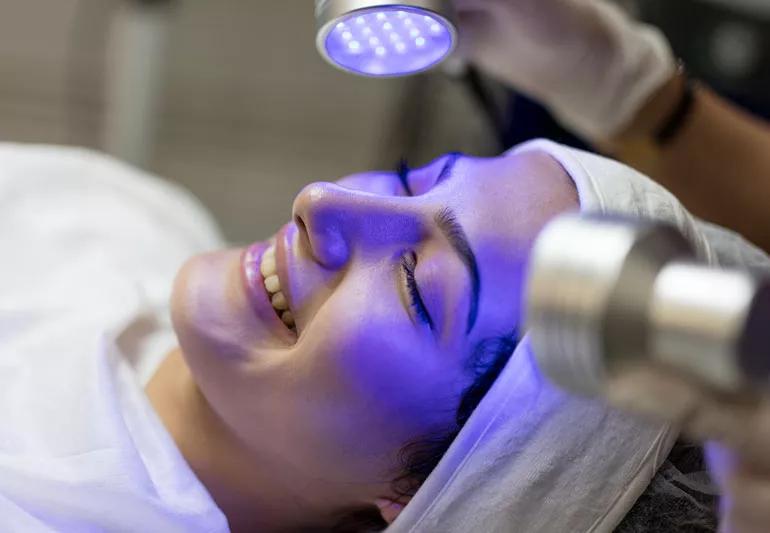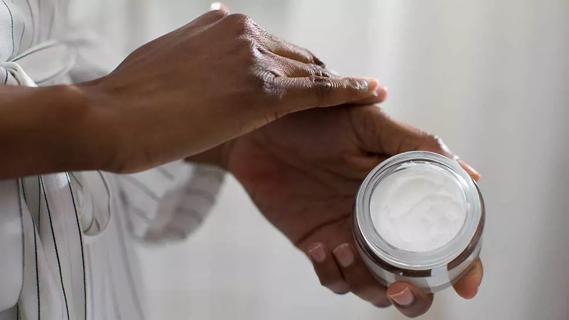Go blue to treat acne, sun damage and skin cancer

Blue light from electronic devices gets a bad rap for straining eyes and disrupting sleep. But this natural wavelength of light isn’t all bad.
Advertisement
Cleveland Clinic is a non-profit academic medical center. Advertising on our site helps support our mission. We do not endorse non-Cleveland Clinic products or services. Policy
Blue light therapy can help clear up acne and treat sun damage and non-melanoma skin cancers. Dermatologist Paul X. Benedetto, MD, explains how it works and who can benefit from feeling blue.
Blue light treatment is most often used as part of a treatment called photodynamic therapy. This therapy can treat some kinds of skin cancer and precancerous spots known as actinic keratoses. These reddish, scaly patches are caused by severe sun damage. Over time, they can turn into squamous cell carcinoma, a type of skin cancer.
To treat cancerous or precancerous spots with phototherapy, a dermatologist first applies a photosensitizing medication to your skin. “That makes the treated area sensitive to damage by the light,” Dr. Benedetto explains.
After letting the drug soak into your skin for an hour or two, the dermatologist shines blue light onto the treated skin for about 15 minutes. The light kills the cells that absorbed the sensitizing medication. Following the treatment, the damaged skin flakes off, leaving healthier, younger-looking skin behind.
For the best results, Dr. Benedetto says you’ll probably need to repeat the treatment two or three times, about four to six weeks apart.
“Photodynamic therapy can be really helpful for treating people who have a lot of sun damage or pre-cancers. Besides reducing the chances of developing skin cancer, it improves the appearance of the skin,” he adds.
Advertisement
Blue light can also spell lights out for some types of acne. Many cases of common acne are caused by a bacterium called Propionibacterium acnes, or P. acnes, which lives on your skin. And P. acnes just so happens to emit its own photosensitizer, which makes it sensitive to blue wavelengths of light.
Shining blue light onto acne-prone skin can kill the bacteria and clear up blemishes. But it’s not magic.
Blue light therapy doesn’t work for everyone, and it might take several sessions to find out if your acne is sensitive to blue light. If it is, you might still need to use other acne treatments, like prescription creams. But for some people, the treatment can light the way to clearer skin.
It’s possible to buy blue light devices to treat acne at home. But they may not be worth the investment. “I’d recommend having a dermatologist do it,” Dr. Benedetto says.
And because not everyone’s acne responds to blue light, purchasing a device might be a waste of time and money. Dermatologists can steer you toward the acne treatments that are most likely to work for you. If blue light is a good option, the devices in the doctor’s office are more powerful than those you can buy for at-home use.
Blue light therapy is safe for most people, though it isn’t recommended for people with photosensitivity disorders (diseases that cause sensitivity to the sun).
When they’re used to treat acne, blue light treatments have few side effects, though some people might notice redness or dry skin.
However, blue light does have some side effects when it’s used with a photosensitizer as part of photodynamic therapy for skin cancer or sun damage:
For patients with many years of sun damage, blue light can be a great tool for reducing skin cancer risk and improving the look of your skin — and that should leave you feeling anything but blue.
Advertisement
Learn more about our editorial process.
Advertisement

With repeat injections over time, you may be able to slow the development of new wrinkles

It’s critical to have the proper eyewear if you plan to look up at the sun, especially during the total solar eclipse on April 8, 2024

Polarized lenses have an added benefit of a special coating that reduces glare on reflective surfaces like water and snow

Pantothenol is a powerful moisturizer and can help repair damaged skin and hair

This alternative to retinol may be easier on sensitive skin

Day creams should protect your skin, night creams should soothe and repair it

Pure cocoa butter can help keep your skin supple, with a subtly delicious scent

Keep your showers short and lukewarm, and moisturize promptly after with a cream containing ceramides

Type 2 diabetes isn’t inevitable with these dietary changes

Applying a hot or cold compress can help with pain